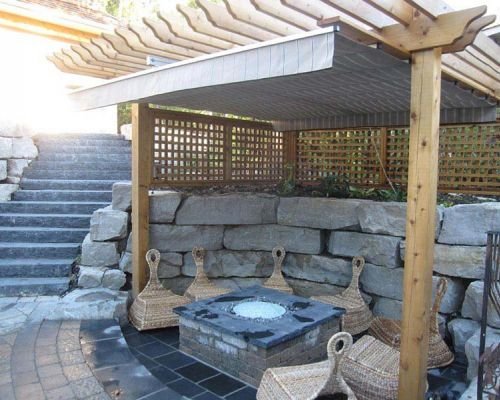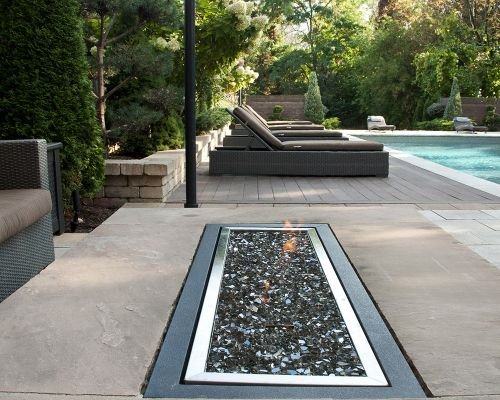
Imagine transforming your Toronto yard into a stunning, eco-friendly sanctuary that balances breathtaking beauty with environmental responsibility. How can homeowners create landscapes that are resilient, vibrant, and sustainable amidst the city’s diverse neighborhoods and changing seasons? This work explores innovative design principles—native plants, permeable materials, rain gardens, and smart irrigation—that work harmoniously to reduce water use, support local ecosystems, and prevent erosion. It’s about more than aesthetics; it’s a conscious effort to nurture urban biodiversity and enhance property value. As technology advances, the future promises smarter, more efficient landscapes—integrating renewable energy, advanced materials, and data-driven solutions—to craft outdoor retreats that thrive long-term. But can these sustainable principles truly transform everyday outdoor spaces into ecosystems that benefit both residents and the planet? This exploration invites readers to envision a new era of gardening—where beauty and sustainability are not just compatible but interconnected.
Transform Your Outdoor Space with Toronto Landscape & Design
Looking to elevate your Toronto backyard? Toronto Landscape & Design (TLD) specializes in creating stunning outdoor environments through expert natural stonework, water gardens, irrigation systems, and retaining walls. Our award-winning designers take everything into consideration, ensuring each project reflects your unique style and needs. Whether you want a tranquil water feature or durable retaining walls, our team delivers exceptional craftsmanship tailored to your property. Trust TLD to bring your vision to life with innovative solutions and meticulous attention to detail. For a professional backyard makeover, contact us today at 1.416.644.0499 or email mike@torontolandscapedesign.com.

Transform Your Toronto Yard Into a Beautiful, Eco-Friendly Retreat
Transforming Toronto yards into beautiful, sustainable outdoor retreats is about more than just keeping up with design trends; it’s about creating personal havens that blend visual appeal with environmental responsibility. In a city renowned for its diverse neighborhoods and changing seasons, having an outdoor space that’s both inviting and eco-friendly can truly enhance daily life. A well-designed yard offers a peaceful escape, boosts property value, and supports local ecosystems—all at once.
The goal is to craft outdoor environments that reflect individual tastes while respecting the environment. Some homeowners dream of lush lawns perfect for gatherings, while others prefer native plantings that require less upkeep and encourage biodiversity. Listening carefully to these preferences allows designers to tailor spaces that are not only stunning but also resilient and sustainable, suited to Toronto’s unique climate.
Design principles rooted in sustainability guide this process, emphasizing native plants, water-efficient features, and eco-friendly materials. Native species thrive naturally, needing less water and fewer chemicals, which simplifies maintenance and reduces environmental impact. Incorporating rain gardens, smart irrigation, and recycled materials further conserves resources and improves stormwater management, creating yards that stay vibrant through seasonal shifts and require less ongoing care.
A truly successful transformation balances beauty with functionality. Thoughtful placement of native plants, natural stone accents, and eco-conscious lighting enhances visual interest while supporting sustainability goals. Features like permeable pavers and rain gardens help manage stormwater naturally, preventing erosion and urban flooding. When these elements work together seamlessly, yards become inviting spaces that encourage frequent use and foster a deeper connection to nature.
Creating this harmony isn’t a one-time effort; it’s an ongoing journey. Regular watering, pruning, and soil enrichment maintain the health and vibrancy of the landscape. Periodic reassessment of plant choices ensures the yard adapts to changing conditions, preserving its resilience and beauty over time. This approach transforms outdoor spaces into dynamic ecosystems that grow more sustainable and captivating with each season.
Ultimately, transforming Toronto yards into eco-friendly retreats is an investment in community well-being, environmental health, and personal enjoyment. When design and maintenance work hand in hand, homeowners can enjoy outdoor spaces that are as beautiful as they are responsible—spaces that will thrive for generations to come.
Foundations of Sustainable Landscaping for a Greener Toronto
Creating a sustainable landscape starts with understanding core principles that prioritize environmental health and resource efficiency. Native plants suited to Toronto’s climate are a cornerstone—they thrive naturally with less water, fertilizers, and pesticides, making them easier to maintain and gentler on the environment. Using these plants reduces the need for chemical inputs and conserves water, supporting local ecosystems while keeping your yard vibrant year-round.
In addition to native species, eco-friendly materials like recycled gravel, sustainably sourced wood, and permeable pavers play a vital role. These choices help minimize the landscape’s carbon footprint and support resilience. Recycled and renewable materials also reduce waste and encourage sustainable construction practices, ensuring your yard remains both beautiful and environmentally responsible.
Water conservation is fundamental. Installing drip irrigation systems, rain gardens, and rain barrels captures natural water sources and minimizes runoff. These features work with native plants to create landscapes that require less supplemental watering, even during dry spells, while helping prevent erosion and urban flooding. This approach aligns with a broader effort to work with nature rather than against it.
Healthy soil forms the foundation of any sustainable landscape. Practices like composting, mulching, and organic amendments naturally enrich the soil, fostering a thriving environment for native plants. Rich, balanced soil supports beneficial insects, reduces the need for chemical fertilizers, and increases resilience against pests and weather fluctuations, making your yard more durable over time.
Designing with functionality in mind enhances both beauty and eco-efficiency. Thoughtful placement of native plants, natural stone features, and eco-conscious lighting not only elevates visual appeal but also supports stormwater management and energy conservation. Features such as rain gardens, green walls, and permeable paving help manage water naturally, preventing erosion and reducing urban heat.
Maintaining this balance requires ongoing care. Regular watering, pruning, and soil enrichment keep plants healthy without heavy reliance on chemicals. Periodic reassessment of plant choices ensures the landscape adapts to changing conditions, maintaining its resilience and vibrancy. Consistent, mindful practices turn your yard into a dynamic, eco-friendly ecosystem.
Applying these principles across Toronto’s diverse neighborhoods proves that sustainable landscaping is both practical and achievable. Whether upgrading a small backyard or undertaking a full renovation, native plants, stormwater features, and recycled materials can transform outdoor spaces into lush, resilient retreats.
This ongoing commitment to eco-conscious design creates landscapes that are not just beautiful but also serve as vital contributors to urban sustainability. By working with nature and prioritizing resource efficiency, homeowners can craft outdoor environments that support local ecology while providing year-round enjoyment.

Achieving a Perfect Balance of Beauty and Sustainability in Your Outdoor Space
Creating a harmonious balance between beauty and sustainability in yard transformations starts with thoughtful design choices that serve both visual appeal and ecological health. Native plants are a key element—they provide vibrant colors and textures that shift with the seasons, yet they thrive naturally in Toronto’s climate. This means your yard remains lush and lively with minimal water, fertilizers, or chemicals, making it easier to maintain and more eco-friendly.
Using natural materials like stone, reclaimed wood, and permeable pavers also helps achieve this balance. These durable, attractive elements reduce runoff and improve drainage, blending seamlessly with the landscape. Incorporating features such as rain gardens or green roofs not only adds visual interest but actively manages stormwater, preventing erosion and flooding while enhancing the overall aesthetic.
Lighting can elevate the design without sacrificing sustainability. Solar-powered path lights or uplights on trees create a warm, inviting atmosphere after sunset, all while consuming renewable energy. When thoughtfully placed, lighting highlights key features and adds ambiance, making the yard more welcoming at night without increasing energy consumption or environmental impact.
Water features like small ponds, waterfalls, or rain gardens introduce a natural serenity that ties the landscape together. These elements support local wildlife—birds, bees, and butterflies—enriching your yard’s ecosystem. When integrated with native plants and natural materials, water features become focal points that exemplify the harmony between visual beauty and environmental responsibility.
Design with purpose by considering how each element interacts within the space. Every plant, material, and feature should work toward creating a cohesive environment that feels both natural and intentional. Drought-tolerant plants, energy-efficient lighting, and pathways that encourage walking and soil preservation all contribute to a landscape that’s both stunning and sustainable. This deliberate approach ensures your yard remains inviting and eco-friendly, encouraging regular use and enjoyment.
Maintaining this delicate balance requires ongoing care that respects the environment. Regular pruning, mulching, and soil enrichment keep plants healthy without over-reliance on chemicals. Periodic reassessment of your plant choices allows your landscape to adapt to changing conditions, ensuring it stays resilient and vibrant for years to come. When sustainability is woven into every aspect of the design, your outdoor space evolves into a thriving, beautiful retreat that benefits both you and the planet.
To deepen your understanding of sustainable landscaping practices, exploring resources on eco-friendly yard design can be incredibly helpful. For comprehensive guidance and innovative ideas, you might find this article on sustainable landscape design strategies insightful: sustainable landscape design. Integrating these principles ensures your outdoor space remains both beautiful and environmentally responsible for years to come.
Real-World Applications of Eco-Conscious Design in Toronto Gardens
Applying sustainable landscape principles in Toronto yard renovations turns eco-friendly ideas into practical, eye-catching features that homeowners can enjoy every day. Native plants are a popular choice—they’re well-adapted to Toronto’s climate, needing less water and fewer chemicals, which makes maintenance easier and reduces environmental impact. Pairing these with smart irrigation systems, like rain sensors or drip watering, ensures plants stay healthy while conserving water and minimizing waste.
Stormwater management is a key focus. Replacing traditional concrete pathways with permeable pavers allows rainwater to soak into the ground naturally, reducing runoff and easing pressure on city drainage. Rain gardens and small natural ponds not only add visual appeal but also serve as functional elements that handle excess water, prevent erosion, and attract local wildlife. Using recycled materials, such as reclaimed stone or wood, further cuts down on waste while adding character and texture to the landscape.
Healthy soil is the backbone of a resilient yard. Many designers emphasize composting, mulching, and organic amendments to naturally enrich the earth. Rich soil encourages native plants to develop strong roots, supporting biodiversity and increasing resistance to pests and drought. Regular soil care and periodic reassessment of plant choices help the landscape adapt to changing weather conditions, maintaining its vibrancy and resilience over time.
Design elements like natural stone walkways and green walls enhance both beauty and sustainability. Permeable pavers improve drainage and reduce runoff, while water features such as small ponds or waterfalls attract pollinators and birds, turning the yard into a lively ecosystem. These features blend seamlessly, transforming ordinary outdoor spaces into vibrant retreats that celebrate environmental responsibility without sacrificing style.
Maintaining these sustainable features involves consistent, mindful care. Regular pruning, mulching, and soil enrichment keep plants healthy without over-relying on chemicals. Choosing native species that adapt to evolving conditions ensures the landscape remains resilient and inviting. By integrating eco-conscious practices into everyday maintenance, homeowners can enjoy a beautiful, functional yard that continues to thrive and support local ecosystems year after year.

Future Trends and Innovations in Sustainable Yard Transformations in Toronto
Looking ahead, the future of eco-friendly yard transformations in Toronto is set to be shaped by innovative technologies and a deeper commitment to sustainability. Smart irrigation systems, which can adjust watering schedules based on real-time weather data, are becoming more accessible and efficient. These systems not only conserve water but also reduce maintenance efforts, making eco-conscious landscaping easier for homeowners. Simultaneously, advances in sustainable materials—such as biodegradable composites and recycled plastics—are expanding design options, allowing for durable, environmentally friendly features that blend seamlessly into outdoor spaces.
Renewable energy will play an increasingly prominent role in landscape design. Solar-powered lighting, water features, and even outdoor heaters are gaining popularity, offering eco-friendly alternatives that reduce reliance on non-renewable resources. As climate challenges intensify, the emphasis on drought-tolerant, native plants will grow stronger; these resilient species require less water and fewer chemicals, helping yards withstand extreme weather while supporting local ecosystems. This shift ensures landscapes remain vibrant and sustainable long-term, even in the face of climate variability.
Regenerative practices are poised to become standard, focusing on restoring soil health and bolstering biodiversity rather than merely maintaining aesthetics. Techniques like composting, mulching, and soil inoculation with beneficial microorganisms will help rebuild natural ecosystems within residential yards. These methods not only improve plant resilience and growth but also contribute to carbon sequestration and attract pollinators, transforming yards into active contributors to urban ecological health.
Technology will continue to enhance planning and visualization, making sustainable design more accessible and precise. Landscape software and virtual reality tools enable homeowners and designers to preview projects, tweak elements, and see how different features interact before installation. Data-driven approaches—such as monitoring soil moisture or plant health—will optimize resource use, reduce waste, and ensure landscapes are both beautiful and resilient with minimal environmental impact. This integration of technology fosters smarter, more adaptable outdoor spaces.
As awareness around ecological responsibility deepens, landscape design will increasingly prioritize habitat creation. Incorporating native plants, water features, and natural materials will support pollinators, birds, and beneficial insects, enriching the yard’s ecosystem. These trends reflect a broader move toward landscapes that serve as vibrant, resilient habitats, seamlessly blending aesthetic appeal with environmental purpose. The result will be outdoor retreats that are not only stunning but actively contribute to Toronto’s ecological vitality, ensuring these sustainable visions become the standard rather than the exception.



